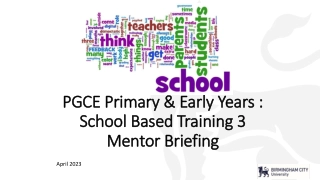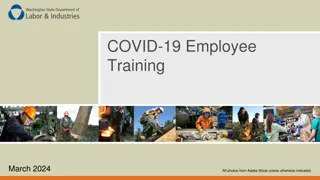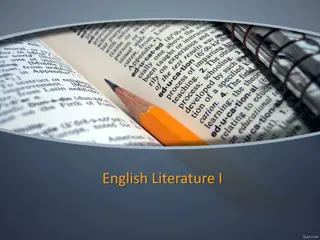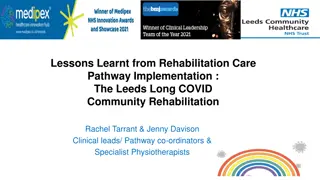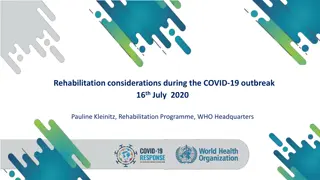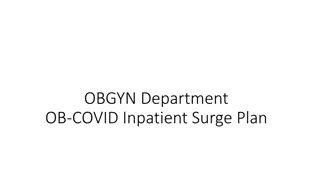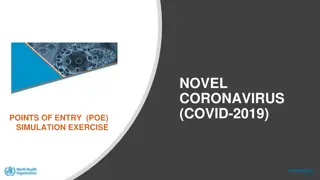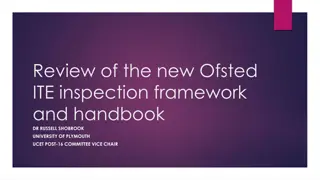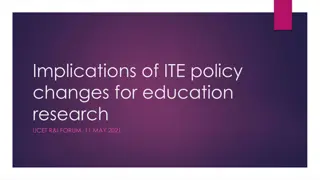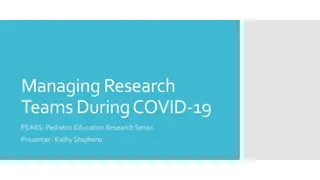Challenges and Opportunities in English ITE Programs During the COVID-19 Pandemic
The COVID-19 pandemic posed significant challenges for Initial Teacher Education (ITE) programs in England, leading to abrupt closures of schools and universities. This prompted a shift towards virtual learning, impacting the practice-theory nexus in teacher education. The response of higher education institutions, the adaptation of provisions, and the curtailment of teaching practice were key themes that emerged from interviews with program leaders. Explore how ITE programs navigated these challenges and opportunities amidst the pandemic.
Download Presentation

Please find below an Image/Link to download the presentation.
The content on the website is provided AS IS for your information and personal use only. It may not be sold, licensed, or shared on other websites without obtaining consent from the author.If you encounter any issues during the download, it is possible that the publisher has removed the file from their server.
You are allowed to download the files provided on this website for personal or commercial use, subject to the condition that they are used lawfully. All files are the property of their respective owners.
The content on the website is provided AS IS for your information and personal use only. It may not be sold, licensed, or shared on other websites without obtaining consent from the author.
E N D
Presentation Transcript
ITE in England and the CV ITE in England and the CV- -19 Pandemic: challenges and opportunities challenges and opportunities 19 Pandemic: UCET R&I Symposium (Virtual) 19thJanuary 2021 Linda la Velle (Bath Spa University) Stephen Newman (Leeds Beckett University) with Catherine Montgomery (University of Durham) and David Hyatt (University of Sheffield)
The CV-19 Snapshot Part of a global data capture: what was the effect on ITE of the abrupt closure of schools and universities? ITE programme leaders from four English universities interviewed: 2 post 92 (A, C) and two RG (B, D). All OfSTED outstanding ITE providers. Enquiry focussed on what happened to a model of research-informed professional learning when the opportunity for classroom practice is curtailed
Interviewees were asked: 1. What was the immediate effect of news of the pandemic? Was there any specific advice to higher education institutions? 2. How did your institution respond to the threat of the pandemic? Did it virtualise ? If so, how did this take place? What platforms/processes are in place? What pedagogic issues have arisen? 3. What specific effect has this had on the HEI-based elements of your teacher education programme/s? 4. Did you have student teachers on practicum? If so, what will be the impact on the potential curtailment of the length of time they should spend in the classroom? 5. What do think might be the impact upon the practice/theory nexus in teacher education because of changes due to the pandemic?
Emergent themes The lockdown and virtualisation Adaptation of provision Teaching Practice curtailment
The lockdown and virtualisation Immediate panic and anxiety , but leadership in all universities quick to reassure staff and students: The VC s advice was very good caring. We modelled our communication to the trainees on [their] email to staff. (A) Virtualisation quick to happen. VLEs already in place, but varied experience of using them: Staff were nervous about online teaching. I had to say to them, you re not going for an Oscar, and you don t have to provide everything . It forced us to reassess what is really important. (A) Not being able to talk to others face to face is problematic. Some students need to talk with people. It can be difficult for them (C) Agreement that ITE advice was slow to come: The DfE did not prioritise teacher training. ITE was left in limbo. (C)
Adaptation of Provision: ITE online University-based elements online: We decided to go for a four-stage approach. We asked ourselves: 1. What does this trainee need, prior to the session? How can we prepare them for the session? 2. What is the instructional part of the session? What is the key message you want to get across? 3. How can you get the trainees working together collaboratively? Trying to mimic what is happening in the classroom via an on-line pedagogic approach. 4. How do you know that they are learning? We recorded all the sessions so that if they [trainees] were interrupted, e.g. by children around their feet, they could then go back to it. This approach has taken time to develop and was not without initial anxiety from the staff. (A)
Adaptation of Provision: Issues of Equity Circumstances of digital connectivity varied widely Each university operated a no detriment policy Innovation in tasks and assessment: e.g. trainees recording their teaching on a specific topic/concept and accepting peer feedback (D); microteaching via BlackBoard Collaborate (C) and writing schemes of work (A).
Theory vs Practice Additional time for reading and reflection enabled: More time to think, which enabled a deeper understanding of ideas sooner in the programme. (B) If I m really honest, this space has allowed them to really focus on assignments and tasks and their own practice, not being in the classroom, has worked really well for a lot of trainees: they ve got the theory more. (A) Students are having more time to engage with, and reflect on, the pedagogical literature which has made some comment I ve done this reading which has helped me to make more sense of what I was doing in the classroom , which wouldn t have happened normally as they would still have been on placement. (D) Evidence of raised quality of written assignments
Teaching Practice Curtailment Trainees lost 8-9 weeks (up to 45 days of the recommended 120 days 37.5% of time in schools) Some students are frustrated and upset as they are missing 9 weeks of getting better at their teaching. (C) Up to a third of placement schools did not have the capacity to continue to work with the trainees equity Some trainees volunteered, e.g. to help with remaining pupils or to teach online equity Trajectory to qualification DfE using providers judgements Universities adopted similar methods of analysis Additional time for portfolios of evidence but limited evidence?
Hit the ground running Time lost for practice means that: Students will go into schools next year feeling they have had a lot of opportunities to think about how they teach but will be wishing they had done more actual teaching. (D) They are supposed to be practising teaching, but they are having to do completely different things. (D) They may struggle next year as NQTs [Newly Qualified Teachers] with the bridging module and the Teach First dissertation module. This may affect their continuation in the master s programme. (A) Consequences for those not hitting Standards at point of lockdown Consequences for placements for 2020-21 cohort
Emerging Impact Pre-existing ITE tensions thrown into sharper relief: Marketisation; recruitment and retention; accountability; placements Effect of lost TP time, but gained R&R time? Issues of authenticity in TE Training in online pedagogy for all. Issues of the digital divide
Improving online teaching and learning A model for meaningful online placement experiences Effective addressing of Teachers Standards Research-based teachers knowledge enhanced by digital technology
Knowledge Enhancement Framework Knowledge Enhancement Framework la Velle and Flores 2018 1. Generation of new knowledge from research 2. Acquisition of K by teachers and trainees 3. Mediation of K into PCK 4. Utilisation of K within cycle of pedagogic action
Post-Covid Pedagogy: a knowledge enhancement framework for demonstrating evidence of the Teachers Standards 1. Set high expectations which inspire, motivate and challenge pupils; 2. Promote good progress and outcomes; 3. Demonstrate good subject and curriculum knowledge; 4. Plan and teach well-structured lessons; 5. Adapt teaching to respond to the strengths and needs of all pupils; 6. Make accurate and productive use of assessment; 7. Manage behaviour effectively to ensure a good and safe learning environment; 8. Fulfil wider professional responsibilities.
Acknowledgements Our thanks is due to the ITE Programme Leaders and other colleagues at each of our universities for their time and information We also thank Catherine Montgomery and David Hyatt, for their contribution to this research and who have co-authored the full paper: Initial teacher education in England and the Covid-19 pandemic: challenges and opportunities https://www.tandfonline.com/doi/full/10.1080/02607476.2020.1803051 Linda la Velle l.lavelle@bathspa.ac.uk Stephen Newman s.n.newman@leedsbeckett.ac.uk
Special Issue of JET Special Issue of JET: Learning from CV-19: continuity or change in teacher education? Deputy Editor Rowena Passy and International Board member Honggang Lui Response of CV-19 challenge Longer term continuities and/or changes Adaptation of teacher education to new normal 300 word abstract by 31stMarch 2021 to Rowena.passy@Plymouth.ac.uk More info: https://www.tandfonline.com/toc/cjet20/current


